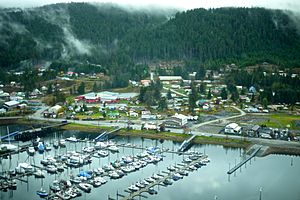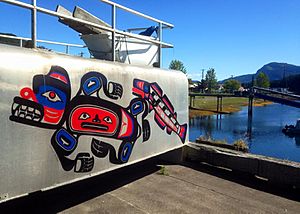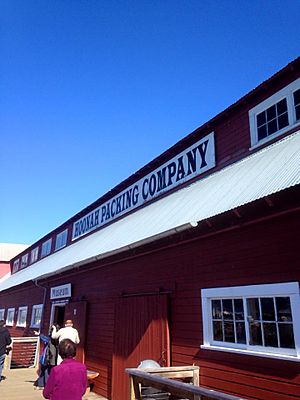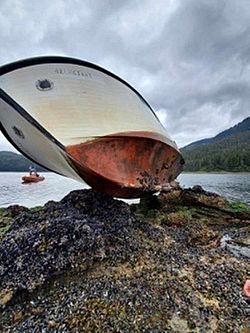Hoonah, Alaska facts for kids
Quick facts for kids
Hoonah, Alaska
Xunaa / Gaaw Yat’aḵ Aan
|
|
|---|---|

Aerial photo of Hoonah
|
|
| Country | United States |
| State | Alaska |
| Census Area | Hoonah-Angoon |
| Incorporated | June 8, 1946 |
| Area | |
| • Total | 7.13 sq mi (18.47 km2) |
| • Land | 5.87 sq mi (15.20 km2) |
| • Water | 1.26 sq mi (3.28 km2) |
| Elevation | 52 ft (16 m) |
| Population
(2020)
|
|
| • Total | 931 |
| • Density | 130.58/sq mi (50.41/km2) |
| Time zone | UTC-9 (Alaska (AKST)) |
| • Summer (DST) | UTC-8 (AKDT) |
| ZIP code |
99829
|
| Area code | 907 |
| FIPS code | 02-33360 |
| GNIS feature ID | 1403488 |
Hoonah (Tlingit: Xunaa or Gaaw Yat’aḵ Aan) is a community mostly made up of Tlingit people. It is located on Chichagof Island in Alaska's panhandle. Hoonah is about 30 miles west of Juneau, across the Alaskan Inside Passage.
Hoonah is the only main city on Chichagof Island. This island is the 5th largest in the United States. In 2020, about 931 people lived in Hoonah. This was an increase from 760 people in 2010. During the summer, the population can grow to over 1,300. This depends on how many people come for fishing, boating, hiking, and hunting.
The name "Hoonah" became the official spelling in 1901. This happened when the Hoonah branch of the United States Post Office was opened. "Hoonah" is how you say the Tlingit name Xunaa. It means "protected from the north wind."
Contents
History of Hoonah
The Huna Tlingit people first lived in what is now Glacier Bay National Park. They also lived near Icy Strait, Cross Sound, and the outer coast. Two big natural events made the Tlingit people leave their homeland. These were a fast-moving glacier in Glacier Bay and a tsunami caused by a landslide in Lituya Bay. Tlingit stories tell about these events. They also explain how the clans eventually settled in Xunaa, which is Hoonah.
Here is a timeline of some important events in Hoonah's modern history:
- 1750s - Clans settled in Xunaa after leaving Glacier Bay due to glaciers.
- 1880 - The North West Trading Company built the first store in Hoonah.
- 1881 - A Presbyterian church mission and school were built.
- 1887 - Between 450 and 500 people were living in the village for the winter.
- 1901 - The Hoonah post office officially opened.
- 1912 - The Hoonah Packing Co. built a large cannery north of town. This cannery was used for many years. Today, it is a tourist attraction at Icy Strait Point.
- 1934, 1936 - The Hoonah Indian Association was formed. It became a recognized tribe that could act for the Huna Tlingit people.
- 1944 - A large fire destroyed much of Hoonah. Many valuable Tlingit cultural items were lost. The United States government helped rebuild the town.
- 1953 - This was the last year the Icy Strait Salmon Company fully operated as a canning business. After this, it was used to maintain fishing boats until 1999.
- 1964 - The first class graduated from Hoonah High School in May.
- 2001 - Work began on Icy Strait Point at the old Hoonah Packing Company site.
- 2004 - The first large cruise ship, Celebrity MV Mercury, visited Icy Strait Point.
- 2007 - The ZipRider, one of the world's largest ziplines, opened at Icy Strait Point.
- 2010 - A fire destroyed the Icy Strait Lumber Mill. No criminal activity was suspected.
The town of Hoonah is shown on the Discovery Channel show Alaskan Bush People.
Education and Schools in Hoonah
Sheldon Jackson started the first school and teacher's home in November 1881. Mr. and Mrs. Walter B. Styles first ran the school. Later, the Reverend and Mrs. John McFarland took over in 1884. By 1885, 219 Tlingit students were enrolled. This included children and adults.
In 1923, a government school was built. This school was replaced in 1932 by a Bureau of Indian Affairs school. Today, Hoonah City Schools serves all elementary and secondary students in Hoonah. Six students graduated from Hoonah City Schools in 2015.
Hoonah Packing Company History
The Hoonah Packing Company ("HPC") was built in 1912. It was one of eight canneries in the area at that time. Canning fish was Hoonah's main industry. HPC was sold many times. It eventually belonged to Wards Cove Packing.
The cannery stopped operating in 1954. However, commercial fishermen still used it. They stored and repaired their boats and gear there.
Geography of Hoonah
Hoonah is located on the north shore of Chichagof Island. It is on Icy Strait, at 58°6′34″N 135°26′11″W / 58.10944°N 135.43639°W. The communities of Whitestone Logging Camp and Game Creek are just south of the city. The port in Hoonah is called Port Frederick.
Other towns on Chichagof Island include Tenakee Springs to the south and Pelican to the west. In 2009, a study looked into building a road from Hoonah to Pelican. This road might also connect to Tenakee Springs. The goal was to bring energy from hot springs to Hoonah. This would help lower heating and energy costs. Most people in Tenakee did not want the road. People in Pelican generally supported it.
The United States Census Bureau says Hoonah covers about 7.13 square miles (18.47 square kilometers). About 5.87 square miles (15.20 square kilometers) is land. The rest, about 1.26 square miles (3.28 square kilometers), is water.
Tongass National Forest is next to Hoonah. It has over 300 miles of unpaved roads. Fun places to visit include Game Creek, Kennel Creek, and Freshwater Bay. Freshwater Bay has a small boat harbor. Whitestone boat landing and False Bay recreation area are also nearby. These areas are hard to reach in winter because of deep snow.
Climate in Hoonah
Hoonah has a climate that is either a humid continental climate or an oceanic climate. This depends on how it is measured.
| Climate data for Hoonah, Alaska (1991–2020 normals, extremes 1941–present) | |||||||||||||
|---|---|---|---|---|---|---|---|---|---|---|---|---|---|
| Month | Jan | Feb | Mar | Apr | May | Jun | Jul | Aug | Sep | Oct | Nov | Dec | Year |
| Record high °F (°C) | 61 (16) |
50 (10) |
59 (15) |
72 (22) |
78 (26) |
86 (30) |
86 (30) |
86 (30) |
75 (24) |
62 (17) |
56 (13) |
55 (13) |
86 (30) |
| Mean maximum °F (°C) | 45.7 (7.6) |
45.0 (7.2) |
48.8 (9.3) |
59.4 (15.2) |
71.2 (21.8) |
76.5 (24.7) |
77.8 (25.4) |
76.6 (24.8) |
67.1 (19.5) |
56.8 (13.8) |
47.5 (8.6) |
44.7 (7.1) |
80.5 (26.9) |
| Mean daily maximum °F (°C) | 34.4 (1.3) |
36.7 (2.6) |
39.9 (4.4) |
48.5 (9.2) |
57.5 (14.2) |
62.3 (16.8) |
64.5 (18.1) |
64.4 (18.0) |
57.7 (14.3) |
48.1 (8.9) |
39.0 (3.9) |
35.6 (2.0) |
49.1 (9.5) |
| Daily mean °F (°C) | 30.6 (−0.8) |
31.7 (−0.2) |
34.1 (1.2) |
41.0 (5.0) |
48.6 (9.2) |
54.6 (12.6) |
57.8 (14.3) |
57.4 (14.1) |
51.3 (10.7) |
42.9 (6.1) |
35.0 (1.7) |
31.9 (−0.1) |
43.1 (6.1) |
| Mean daily minimum °F (°C) | 26.7 (−2.9) |
26.7 (−2.9) |
28.4 (−2.0) |
33.4 (0.8) |
39.8 (4.3) |
46.9 (8.3) |
51.0 (10.6) |
50.5 (10.3) |
44.9 (7.2) |
37.7 (3.2) |
31.0 (−0.6) |
28.3 (−2.1) |
37.1 (2.8) |
| Mean minimum °F (°C) | 13.0 (−10.6) |
15.7 (−9.1) |
16.6 (−8.6) |
24.9 (−3.9) |
31.3 (−0.4) |
39.0 (3.9) |
44.5 (6.9) |
43.1 (6.2) |
34.9 (1.6) |
28.4 (−2.0) |
19.6 (−6.9) |
15.4 (−9.2) |
7.7 (−13.5) |
| Record low °F (°C) | 3 (−16) |
0 (−18) |
6 (−14) |
13 (−11) |
27 (−3) |
31 (−1) |
32 (0) |
30 (−1) |
22 (−6) |
22 (−6) |
2 (−17) |
1 (−17) |
0 (−18) |
| Average precipitation inches (mm) | 6.75 (171) |
5.02 (128) |
4.43 (113) |
3.13 (80) |
2.51 (64) |
2.67 (68) |
3.30 (84) |
4.86 (123) |
7.26 (184) |
9.19 (233) |
8.81 (224) |
7.86 (200) |
65.79 (1,671) |
| Average snowfall inches (cm) | 25.0 (64) |
12.3 (31) |
20.0 (51) |
1.7 (4.3) |
0.0 (0.0) |
0.0 (0.0) |
0.0 (0.0) |
0.0 (0.0) |
0.0 (0.0) |
0.6 (1.5) |
13.4 (34) |
17.0 (43) |
90.0 (229) |
| Average precipitation days (≥ 0.01 in) | 19.5 | 15.8 | 15.7 | 16.9 | 14.7 | 16.0 | 17.8 | 19.3 | 21.6 | 23.7 | 20.1 | 21.0 | 222.1 |
| Average snowy days | 8.1 | 5.9 | 6.5 | 1.0 | 0.0 | 0.0 | 0.0 | 0.0 | 0.0 | 0.3 | 5.2 | 8.0 | 35.0 |
| Source: NOAA | |||||||||||||
People and Economy of Hoonah
| Historical population | |||
|---|---|---|---|
| Census | Pop. | %± | |
| 1880 | 800 | — | |
| 1890 | 438 | −45.2% | |
| 1900 | 447 | 2.1% | |
| 1910 | 462 | 3.4% | |
| 1920 | 402 | −13.0% | |
| 1930 | 514 | 27.9% | |
| 1940 | 716 | 39.3% | |
| 1950 | 563 | −21.4% | |
| 1960 | 686 | 21.8% | |
| 1970 | 748 | 9.0% | |
| 1980 | 680 | −9.1% | |
| 1990 | 795 | 16.9% | |
| 2000 | 860 | 8.2% | |
| 2010 | 760 | −11.6% | |
| 2020 | 931 | 22.5% | |
| U.S. Decennial Census | |||
Hoonah was first recorded in the 1880 U.S. Census as "Koudekan." It was called "Huna" in 1890 and "Hooniah" in 1900. From 1910 onwards, it has been known as Hoonah. The city officially became incorporated in 1946.
Hoonah is the main village for the Huna Tlingit people. They originally lived in Glacier Bay, Icy Strait, and other coastal areas. The four main Tlingit clans in Hoonah are Chookaneidi, T'aakdeintaan, Wooshkeetaan, and Kaagwaantaan. Many other clans and non-native people have moved to or married into the community.
In 2000, there were 860 people living in Hoonah. About 60% of the people were Native American. About 29% were White. The average household had about 2.83 people. The average family had about 3.34 people.
The old fish cannery near Icy Strait stopped working in the 1950s. The Huna Totem Corporation (HTC) bought it. The road to the site, Cannery Road, was paved in 2000. The site was then turned into a place for cruise ship passengers to visit.
From May to September, cruise ships stop near Icy Strait Point. Visitors from these ships help Hoonah's economy during the warmer months. The former Hoonah Air Force Station was once a communication facility. It closed in the mid-1970s. Now, it is the starting point for a zip-line, which is one of the longest in the world. It ends at the old cannery site.
Cruise ship passengers, fishing boats, and summer boaters bring money to the city. The logging industry closed in the early 1990s, which hurt the town's economy. However, limited logging, tourism, and fishing have helped the town recover.
Hunters, hikers, campers, boaters, and fishers visit Hoonah as tourists all year. The mild weather, similar to Seattle's, attracts many visitors.
Transportation in Hoonah
Hoonah is an island community. This means you can only get there by boat or plane.
Ferry Service
The Alaska Marine Highway serves Hoonah with the M/V LeConte. This ferry service offers a slower but often cheaper way to travel between Hoonah and Juneau.
The city of Hoonah has a small boat harbor. It also has a large vessel mooring harbor and a new boat haul-out facility. The Alaska Department of Transportation built a new ferry facility in Hoonah. It opened in early 2001.
Airport Access
The Hoonah Airport was made bigger in 2011. It now has a 3,000-foot runway. There are plans to make the airport even larger. This would allow military C-130 planes from the Coast Guard and Air National Guard to land in Hoonah.
The airport offers flights through Alaska Seaplanes. They have many flights each day between Hoonah and Juneau. You can also fly to other local communities. In Juneau, you can connect with Alaska Airlines for longer trips. You can also find other small planes to remote villages from Juneau.
Hoonah's Infrastructure and Services
Hoonah has a school for students from kindergarten to 12th grade. About 120 students attend this school. There are two grocery stores, a place to buy fuel, and a hardware store. You can also find a bar, a hotel, two cafes, and an auto service center. There are several gift shops and bed and breakfasts.
Hoonah also has a U.S. post office and a regional U.S. Forest Service office for Tongass National Forest. There is a fish processing facility and a sporting goods store. In 2015, a local brewery called Hoonah Brewing Company opened. Plans are being made to build a new jail.
Hoonah is an Alaskan first-class city. This means it provides all city services. These include police, utilities, and road maintenance. The city also has a city park, built in 2010 near the harbor. There is also a youth activity center.
The police department has a five-bed jail. It employs four paid police officers and volunteer reserve officers. The Hoonah volunteer Emergency Medical Service (EMS) was recognized in 2009 for being excellent. The Hoonah Volunteer Fire Department was approved by the Alaska Fire Commission in 2010. The Alaska State Troopers have an office in Hoonah with one wildlife enforcement officer.
The Alaska Courts have a courthouse in Hoonah. A magistrate presides over district court cases there.
The Hoonah Indian Association has a tribal office and a senior citizens center. They provide other services to local tribal members.
Places of Worship in Hoonah
Hoonah has eight churches:
- Sacred Heart Parish (Roman Catholic)
- St. Nicholas Eastern Orthodox Church
- Harbor of Faith Lutheran Church
- Hoonah United Presbyterian Church (ECO)
- Abundant Life Christian Fellowship (Assemblies of God)
- Hoonah Pentecostal Church (United Pentecostal)
- The Salvation Army Corps, Center for Worship and Service
- Hoonah Baptist Fellowship
See also
 In Spanish: Hoonah para niños
In Spanish: Hoonah para niños






